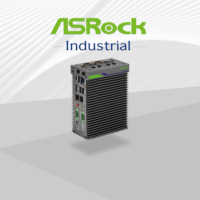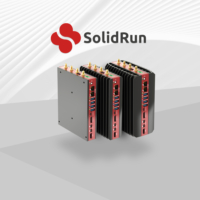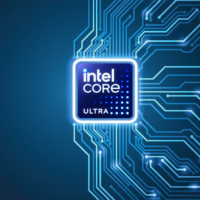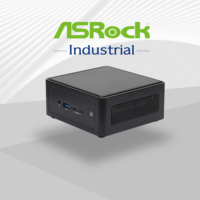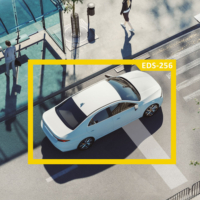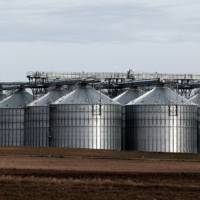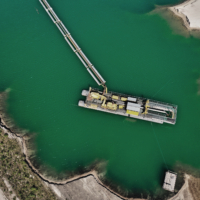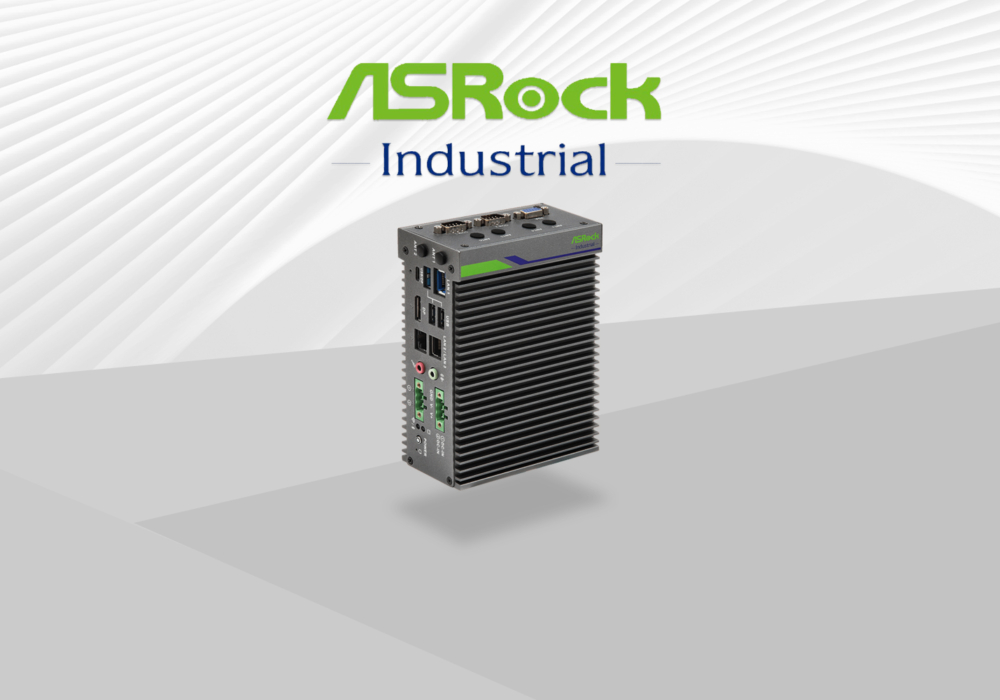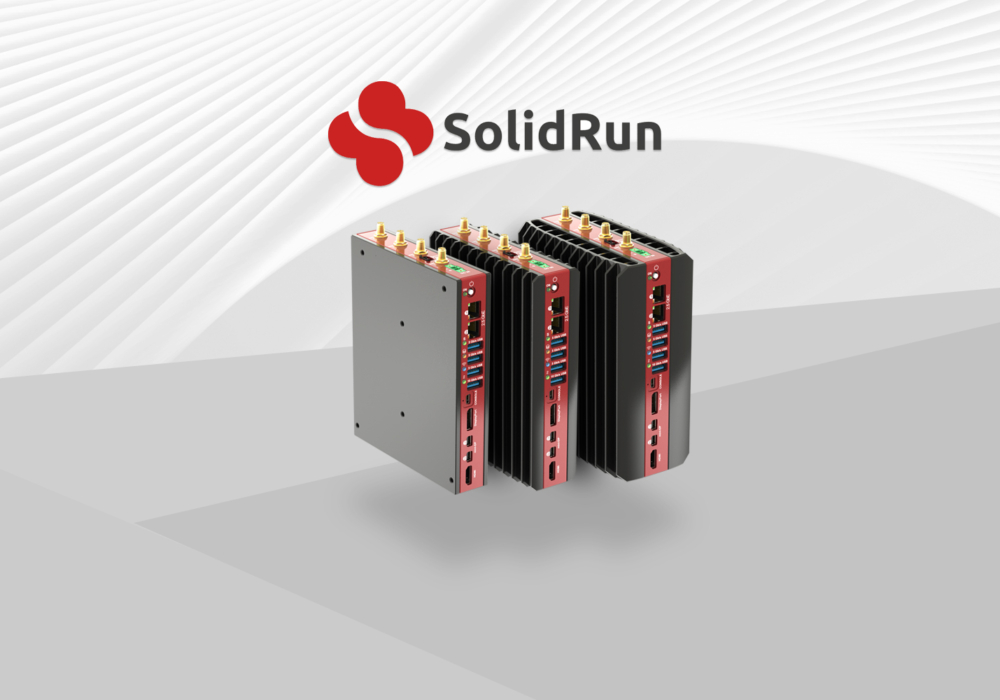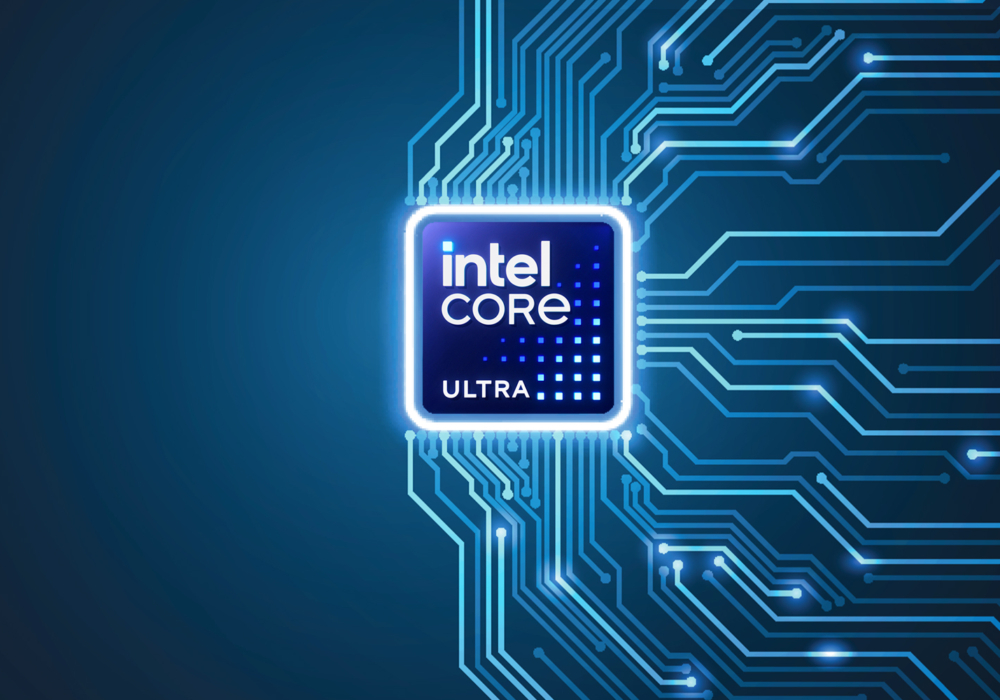In this article:
- A Compact, Rugged Fanless Edge-AI IPC Powered by AMD Ryzen 7840HS Processor and 3 Hailo-8TM AI Accelerators
- Bedrock R7000 Edge AI Features Breakdown
- Main Benefits Bedrock R7000 Edge AI
- Possible Applications Bedrock R7000 Edge AI
- Other Bedrock Family Members
- Bedrock V3000 Basic
- Bedrock R7000 Basic
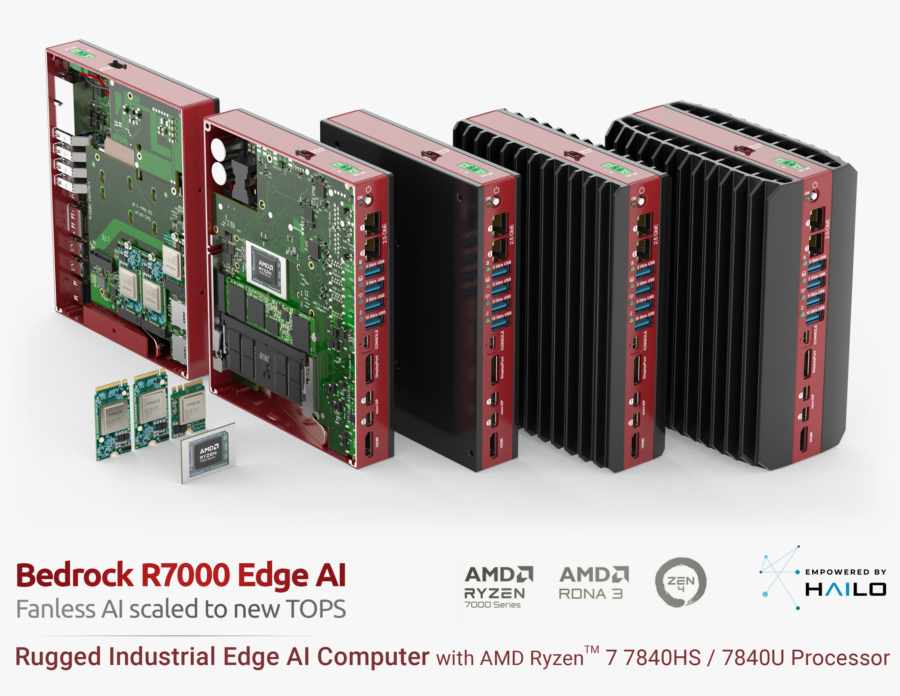
A Compact, Rugged Fanless Edge-AI IPC Powered by AMD Ryzen 7840HS Processor and 3 Hailo-8TM AI Accelerators
SolidRun, a leading technology company, has unveiled its latest innovation – the ground-breaking Bedrock R7000 Edge AI which joins the V3000 and R7000 Basic models (Tile, 30W and 60W) in SolidRun’s Industrial computer line-up.
This cutting-edge Fanless Edge-AI IPC combines the formidable processing power of the AMD RyzenTM 7840HS processor with three Hailo-8TM AI Accelerators. The result is exceptional performance housed within a compact, robust chassis.
The Bedrock R7000 Edge AI marks a significant milestone as the world’s first rugged system design to merge the capabilities of 8-core AMD Ryzen 7040 series processors with multiple Hailo-8 AI accelerators. This synergy brings to life the Bedrock R7000 Edge AI, a powerful solution tailored for various artificial intelligence (AI) applications.
Part of SolidRun’s esteemed Bedrock family of fanless modular industrial PCs, the Bedrock R7000 has been meticulously engineered to thrive in demanding environments requiring vision-based situational awareness. Its durability and reliability make it an ideal choice for tackling challenges in tough settings.
This ground-breaking system seamlessly integrates the state-of-the-art AMD Ryzen 7840HS processor, boasting a 4nm APU with an 8C/16T Zen4 CPU and an integrated RDNA 3 Radeon 780M GPU. Featuring 20 native PCIe Gen4 lanes, the system can fully leverage up to three Hailo-8TM AI accelerators, along with NVME Gen4x4 storage, dual 2.5 Gbit Ethernet, and 4x4K displays. The passive cooling system of the Bedrock R7000 efficiently manages the CPU and all components, operating flawlessly within an industrial temperature range of -40ºC to 85ºC.
The demand for high-performance Edge AI box-PCs is growing exponentially across diverse sectors, including Industry 4.0, robotics, autonomous guided vehicles, healthcare, transportation, smart cities, retail, agriculture, defence, and utility.
Irad Stavi, IPC Product Line Manager at SolidRun, emphasized, “Efficiency and scalability are pivotal in advanced edge AI. The Bedrock R7000 sets new standards as the pioneering fanless Industrial Computer powered by the ultra-efficient AMD Ryzen 7040 processor. Its innovative modular design enables effortless integration of three Hailo-8TM AI accelerators, each capable of 26 Tera Operations per Second (TOPS), or even greater with simple customization.”
Dima Caplan, Product Manager at Hailo, highlighted a crucial aspect of the Hailo-8TM AI accelerator and Hailo AI Software Suite, stating, “The linear scaling of inference performance through module addition is a standout feature. SolidRun’s novel Edge AI platform boasts ample system resources, facilitating remarkable AI performance with perfect scalability.”
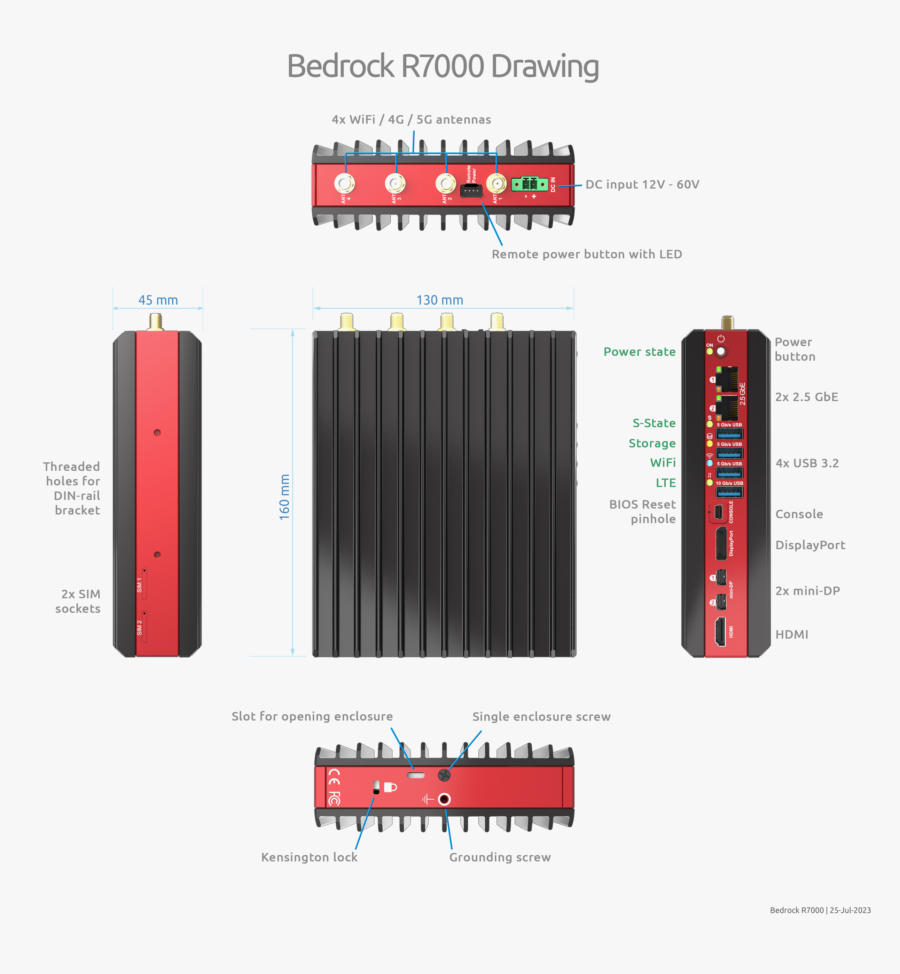
The Bedrock R7000 Edge AI comes equipped with an AMD RyzenTM 7 7840HS / 7840U processor, boasting 8 cores and 16 threads that can operate at speeds of up to 5.1 GHz. Built on the advanced AMD Zen4 4nm microarchitecture, this processor also integrates the AMD Radeon™ 780M GPU, featuring up to 12 compute units (CUs) running at 2700 MHz. The CPU’s power can be finely tuned within a broad range of 8W to 54W through the BIOS settings.
For handling Edge AI workloads, the system accommodates the installation of up to 3 Hailo-8 AI accelerators. These accelerators collectively deliver an impressive inferencing performance of up to 78 Tera Operations per Second (TOPS).
The RAM and storage components are designed to be modular, with 2x SODIMMs supporting up to 64 GB of DDR5 ECC/non-ECC memory. Additionally, the system includes 3 NVME 2280 PCIE Gen4x4 devices, which encompass enterprise-grade NVME with power loss protection (PLP). Both RAM and storage are conduction-cooled to ensure reliable operation even in extreme temperature conditions.
In terms of connectivity, the system offers a versatile array of options, including 4 displays featuring HDMI 2.1 and 3x DP 2.1 outputs. The system also incorporates dual 2.5 Gbit Ethernet ports (Intel I226), optional WiFi 6E with BT 5.3, and the flexibility to include a 5G or LTE modem. Furthermore, there are 4 USB 3.2 ports and a console port. All input/output functionalities are conveniently grouped on a single face, streamlining the integration process.
Compatible with major PC operating systems, its encompasses a wide range from various Linux distributions to Windows Desktop, Server, and IoT versions.
The design of the Bedrock R7000 is characterised by its modular electronic architecture based on System on Module (SoM) technology. Power input is facilitated through a dedicated interchangeable module, allowing for versatile deployment scenarios. The default PM 1260 module offers support for a broad voltage range spanning from 12V to 60V.
Enclosed within a sturdy, heavy-duty machined aluminum casing with an anodised finish, the Bedrock R7000 is available in three distinct variants. These include a 1.0-litre enclosure designed to dissipate up to 30W of heat through convection, a 1.6-litre version capable of managing 60W of heat, and a compact 0.6-litre “Tile” variant optimised for conduction cooling. The enclosure is also well-suited for DIN-Rail mounting, thanks to a specially designed zero-force locking bracket.
Notably, the fanless design of the Bedrock R7000 Edge AI is capable of effectively managing cooling demands of up to 60W, exceeding the cooling capacity of typical fanless PCs of similar size by over threefold. Innovative cooling solutions include liquid metal TIM, 360º stacked heat pipes, a dual-layer chimney effect heat exchanger, and the strategic thermal coupling of internal components. This intelligent thermal management design ensures the system operates reliably within a wide temperature range spanning from -40ºC to 85ºC.
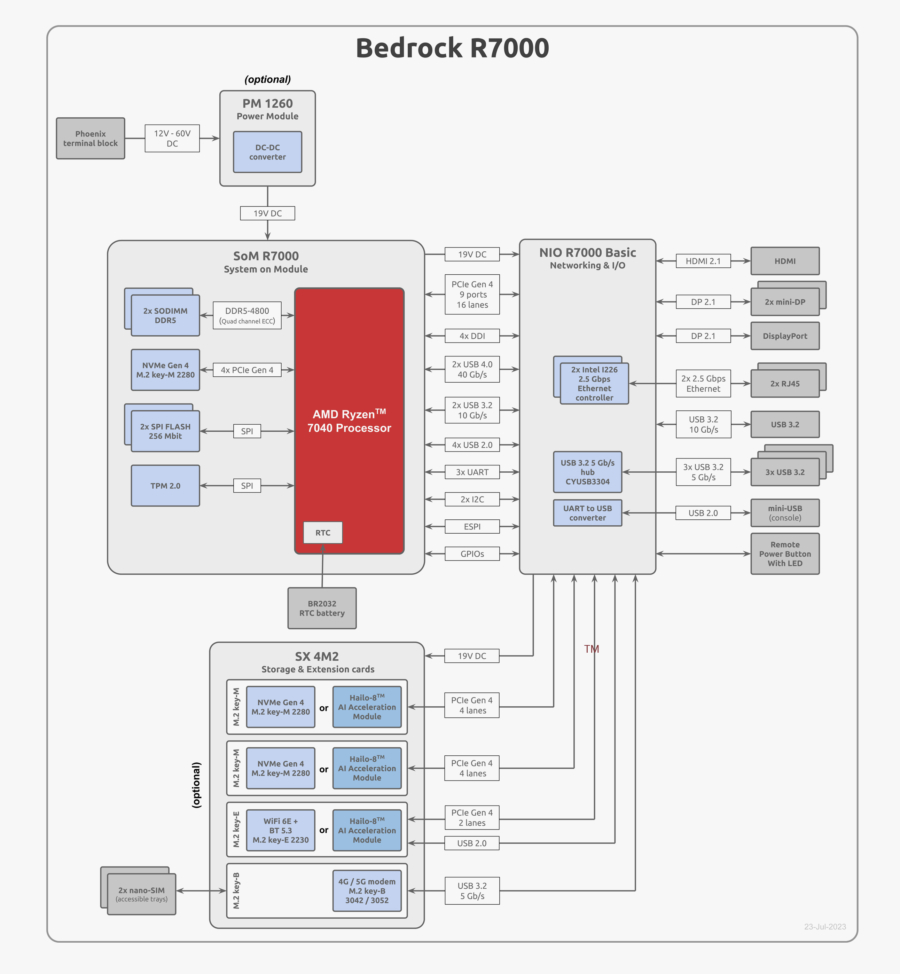
Bedrock R7000 Edge AI Features Breakdown
Fanless AI scaled to new TOPS
- 1st industrial PC with AMD Ryzen and 3 Hailo-8 AI accelerators
- Remarkable AI inferencing performance of 78 TOPS
- State of the art thermal design for operation in -40ºC to 85ºC
- Easy-to-integrate compact design with DIN-Rail mounting, 12V-60V DC input
Highly Efficient Scalable Performance
SolidRun Bedrock R7000 Edge AI is powered by AMD Ryzen 7 7840HS / 7840U processor coupled with up to 3 Hailo-8 AI accelerators, each with 26 Tera Operations per Second (TOPS). The 5.1 GHz 8 Core Zen 4 CPU and integrated AMD Radeon 780M GPU are powerful enough for real-time acquisition of dozens of hi-res video streams and AI inferencing using multiple Hailo-8 accelerators, each at 100% utilisation for AI performance of 78 TOPs – three times the performance of other ruggedised edge AI PCs.
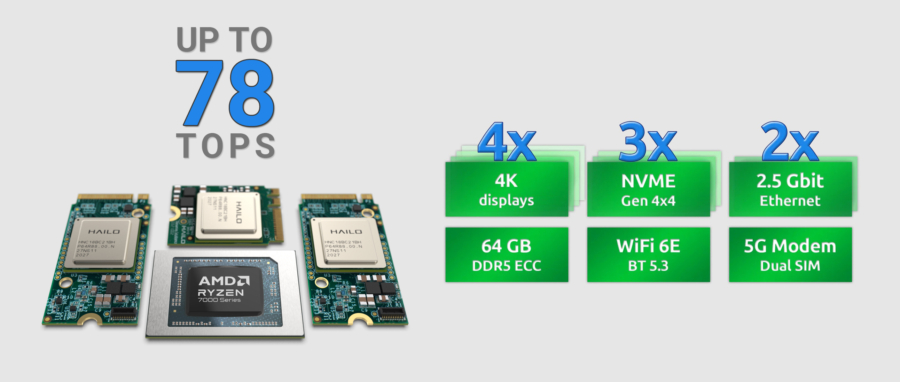
Packed Solid with Features
Edge AI computer has tasks beyond inferencing. Bedrock R7000 Edge AI stand out in computing and graphics performance, as well as in I/O, storage and networking capabilities. 4 display outputs HDMI 2.1 / DP 2.1 each 8K capable or 4x4K are driven by the powerful Radeon 780M GPU. 64 GB DDR5 with ECC, NVME Gen4 2280, 2x 2.5 GbE ports, 5G modem with dual SIM and 4 USB ports. All these features are tightly packed in a fanless enclosure of under 1 litre.
Note: WiFi 6E and up to 2x extra NVME devices can be installed if less than 3 AI accelerators are used.
Remarkable Fanless Cooling
Hot chips require innovative cooling. Bedrock was designed from the ground up for effective fanless cooling. The CPU is thermally coupled to the chassis using liquid metal TIM to reduce thermal resistance. Stacked heat pipes distribute the heat evenly 360º around the all-aluminium chassis.
To optimise convective heat transfer, each chassis wall has two heat exchange layers – aluminium air-ducts that stimulate airflow by chimney effect, and another layer of conventional cooling ribs. As a result, Bedrock can dissipate over 3 times the power of fanless computers of similar size.
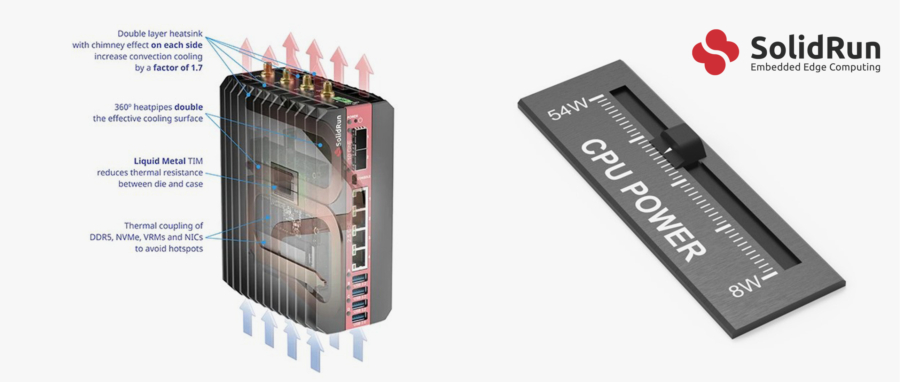
Full Control of CPU Power
With Bedrock R7000 you don’t have to guess how much power the system draws. Instead you can precisely set CPU power limit across an exceptionally broad power range of 8W to 54W. This is particularly useful in scenarios where limited power has to be shared between the IPC and additional devices, and when integration constraints prevent ideal heat dissipation.
Rock Solid Reliability
Bedrock is designed with reliability in mind based on decades of experience in development of IPCs and embedded systems. DC power is through a terminal block with screw locking and has a wide voltage range of 12V – 60V with two stages of regulation. RAM supports ECC. NVMe with power-loss-protection (PLP) can be ordered. Bedrock has redundant SPI Flash to prevent bricking by BIOS corruption as well as WDT and TPM. The enclosure is extremely ruggedised – all-aluminum, fanless and ventless dust-resistant IP40.
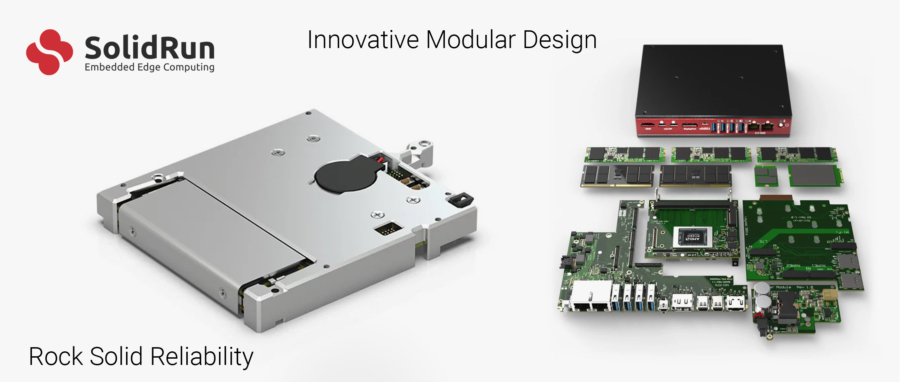
Innovative Modular Design
Bedrock is designed to address the diversity of requirements in the IoT space. This is achieved by partitioning the hardware into the following boards:
- SoM with the CPU, DDR5 and NVMe slots and all native interfaces on 380 pins of high density connectors.
- Networking and I/O board (NIO) with NICs and ports.
- Storage and Extension Cards board (SX) with slots for WiFi, 5G modem and extra NVMe devices.
- Power Module (PM) with DC to DC converter and DC input connector.
This modular design enables agile customisation of Bedrock for addressing specific requirements. SolidRun is developing multiple NIO, SX and PM boards that can be mixed and matched as an off-the-shelf solution and also offers development of custom boards as an ODM service. Customers and 3rd parties that are interested in developing custom NIO, SX or PM boards are welcome to contact SolidRun for support.
Bedrock enclosure is designed with customization in mind. Modification of I/O, power input, antenna openings etc. can be performed cost effectively even in small volume.
Painless Integration
The compact footprint of Bedrock, robust structure, effective fanless cooling and DC input tolerance simplify Bedrock integration. All Bedrock I/O is brought to the front panel, with DC input and antennas in the top panel. The bottom and rear panel are both reserved for mounting, allowing full usability while Bedrock is mounted to a wall or to a desk.
SolidRun offers multiple types of mounting brackets, including lever-based DIN-Rail bracket with locking, wall mount, small stand and ruggedised stand.
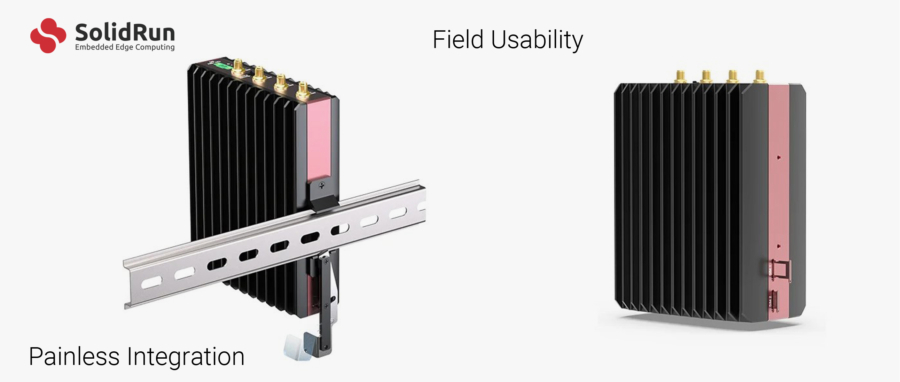
Field Usability
As a fanless, ventless IPC Bedrock requires no maintenance. Bedrock is designed to avoid the need to open it in the field. SIM cards are accessible from the panel using pin-hole trays. Remote power button connector is conveniently located on the top panel. All brackets and mounting fixtures are assembled from the outside. Should the need arise to open Bedrock (e.g. to install a storage device or replace the RTC battery) Bedrock opens by unscrewing a single screw.
The 0.6 Litre Bedrock Tile
When integrating an IPC in tight space convection cooling becomes ineffective and is better replaced with conduction cooling. It is also desirable to make the IPC as compact and thin as possible. Bedrock Tile is designed for these use cases. The ribbed chassis walls are replaced with flat walls with blind threadings for fastening Bedrock Tile to a cold plate. A key feature of Bedrock Tile is that it preserves the 360º internal heat distribution so it can be cooled from either side. With thickness of just 29mm and volume of 0.6 litre, Bedrock Tile is easy to integrate in tight spaces. Having all connectors on one side further simplifies the integration.
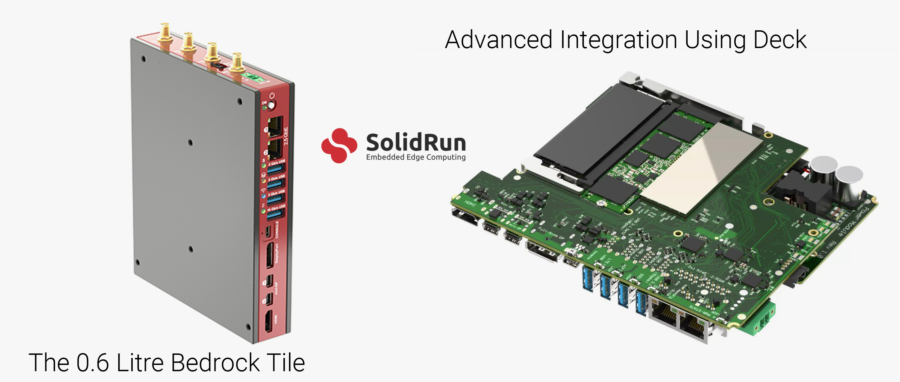
Advanced Integration Using Deck
Some integration scenarios call for custom enclosures (e.g. when additional devices must be installed with the computer in the same housing). To support these use cases Bedrock introduces the Deck concept (deck-of-cards). The SoM, NIO, SX and PM are rigidly held together with fasteners independently of the Bedrock enclosure. The Deck provides first stage cooling for most devices, in particular it includes a copper heat-plate on the CPU. The Deck is fastened to the custom chassis with only 3 screws. Fastening provides thermal coupling to the CPU, RAM, NVMe and FETs. The DC input connector is on wires and can be relocated in the chassis.
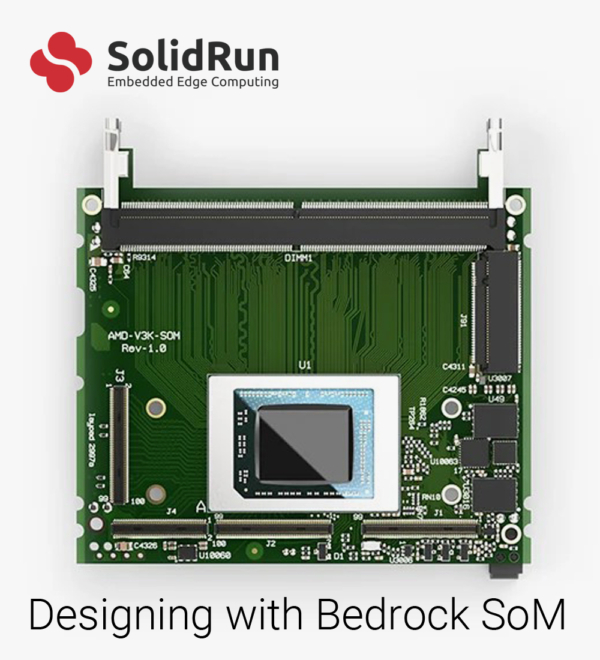
Designing with Bedrock SoM
Bedrock SoM makes a convenient and flexible building block for board designers. For many developers, using Bedrock R7000 SoM would be the best way to develop a custom appliance based on the popular AMD RyzenTM 7040 series. Bedrock SoM makes an attractive platform for that purpose for several reasons.
The SoM is far more self-contained than traditional SoMs. It has not only the essential CPU and RAM, but also NVMe, direct DC input with 12V – 19V tolerance and RTC battery. The SoM is provided in a ruggedized metal skirt that protects the SoM, provides mounting fixture for extension cards and serves as a heat-spreader for secondary heat sources. Copper heat-plate is pre-assembled on the CPU.
Main Benefits Bedrock R7000 Edge AI
- High Performance: The integration of the AMD Ryzen 7840HS processor and multiple Hailo-8 AI accelerators provides significant processing power, enabling the system to handle demanding AI workloads efficiently.
- AI Acceleration: The inclusion of up to three Hailo-8 AI accelerators with a combined inferencing performance of up to 78 TOPS enhances the system’s AI capabilities. This allows for real-time AI inference processing, making it suitable for applications requiring quick decision-making.
- Rugged Design: The fanless, rugged design of the Bedrock R7000 allows it to operate reliably in harsh environments with temperatures ranging from -40ºC to 85ºC. This makes it ideal for deployment in industries and scenarios where traditional computers might not be able to withstand the conditions.
- Modular and Scalable: The modular design of the system, including the ability to adjust CPU power and install additional AI accelerator modules, ensures scalability and adaptability for various use cases.
- Wide Range of I/O: The system provides multiple display outputs, Ethernet ports, USB ports, and wireless connectivity options, enabling seamless integration with different devices and systems.
- Compact Form Factor: Despite its high performance and robust features, the compact form factor of the Bedrock R7000 makes it suitable for space-constrained environments.
- Energy Efficiency: The ability to adjust CPU power within a wide range enables efficient power consumption management, allowing the system to optimise performance based on workload requirements.
Possible Applications Bedrock R7000 Edge AI
- Industrial Automation (Industry 4.0): The system’s high-performance AI capabilities make it suitable for machine vision tasks in manufacturing and industrial automation, including quality control, defect detection, and process optimization.
- Autonomous Systems: Applications such as robotics and autonomous guided vehicles (AGVs) can benefit from the AI processing power and rugged design of the Bedrock R7000, enabling real-time perception and decision-making in dynamic environments.
- Healthcare: The system can be used in medical imaging, patient monitoring, and diagnostics, where AI-powered analysis can aid in detecting anomalies and assisting medical professionals.
- Transportation: In transportation systems, the Bedrock R7000 can support AI-based surveillance, traffic management, and autonomous driving features, enhancing safety and efficiency.
- Smart Cities: The system can contribute to smart city initiatives by enabling AI-driven solutions for traffic management, security surveillance, waste management, and more.
- Retail: Retail environments can utilize AI for customer behaviour analysis, inventory management, and personalized shopping experiences.
- Agriculture: Precision agriculture can benefit from AI-powered analysis of crop health, soil conditions, and environmental data to optimise yields.
- Defense and Security: The rugged design and AI capabilities of the system make it suitable for military and security applications, such as surveillance, threat detection, and situational awareness.
- Utility and Energy Management: The system can be used to monitor and optimise energy consumption, grid management, and predictive maintenance in utility and energy sectors.
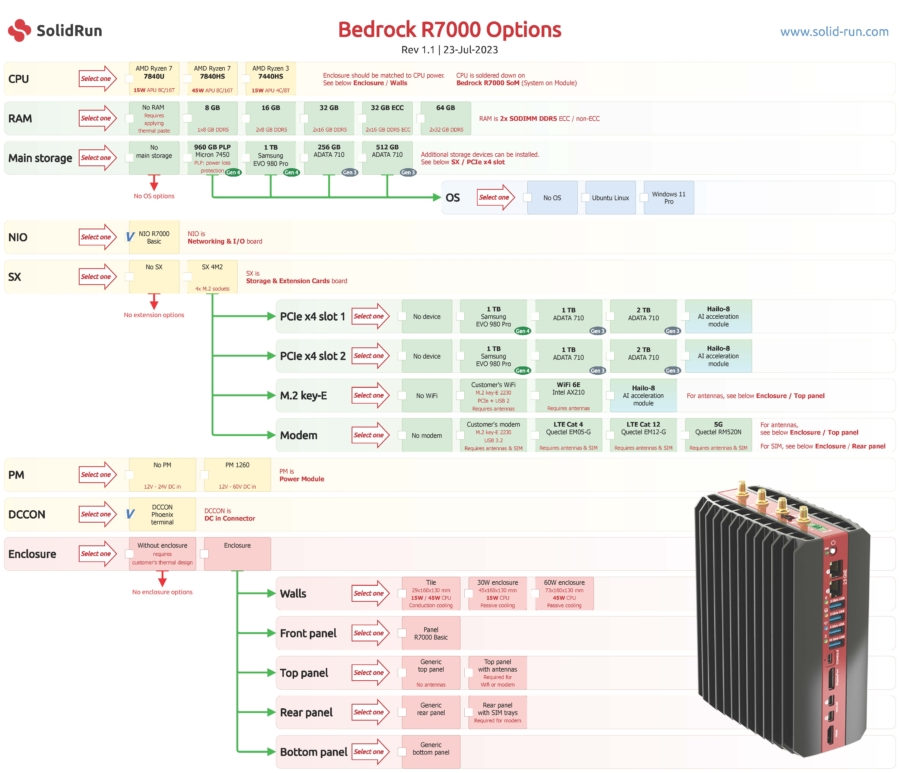
Other Bedrock Family Members
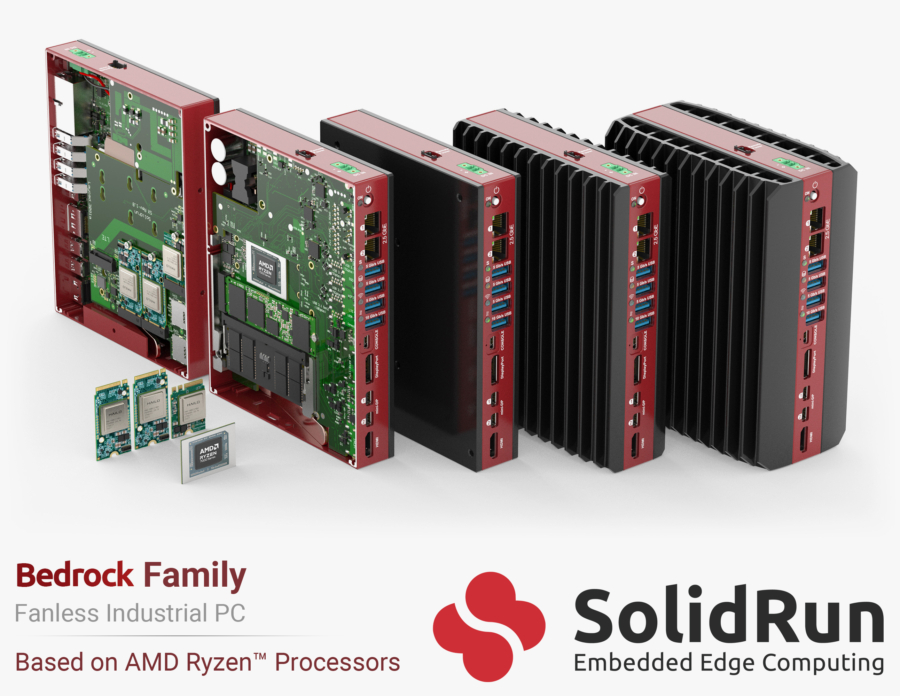
Bedrock V3000 Basic
Bedrock V3000 Basic fanless industrial computer provides exceptional performance in a compact format. Powered by the AMD Ryzen™ Embedded V3000 Processor, the Bedrock V3000 Basic is designed to meet demanding applications under challenging operating conditions.
Compact high-performance fanless industrial computer based on AMD Ryzen™ Embedded V3000 Processor, designed for demanding applications in harsh environments.
- Remarkable performance with 8 Core, 64 GB DDR5 ECC and 3x NVME Gen 4
- State-of-the-art fanless thermal design for operation in -40ºC to 85ºC
- Best-in-class connectivity with dual 10 GbE, 4x 2.5 GbE, 5G and WiFi 6E
- Easy-to-integrate compact design with DIN-Rail mounting, 12V-60V DC input
Solid Performance
SolidRun Bedrock V3000 Basic is powered by AMD Ryzen™ Embedded V3C48 Processor, a state-of-the-art 6nm 8C/16T CPU with industry leading performance and power efficiency. Bedrock PC is utilising the full capabilities of the processor, including 20 lanes of PCIe Gen4 to allow storage, networking and I/O to keep pace with the CPU. The result is unprecedented performance for a compact fanless IPC.
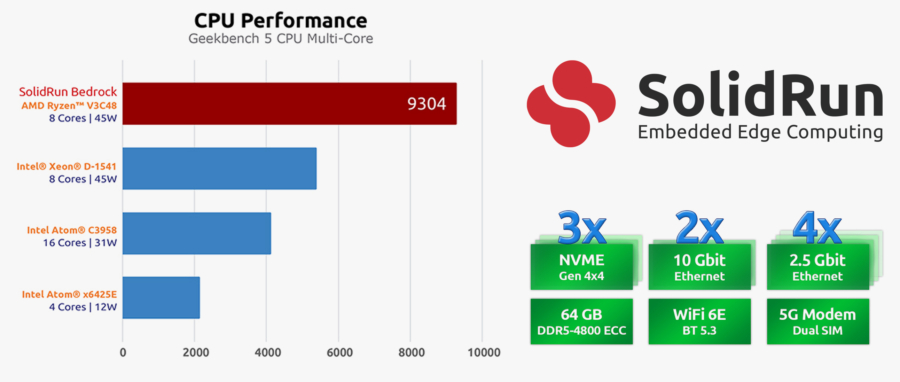
Packed Solid with Features
The memory, storage and networking devices found in SolidRun’s Bedrock V3000 Basic stand out in both performance and capacity. 64 GB DDR5 with ECC, 3x NVME Gen4 2280, 2x 10 GbE SFP+ copper/fibre + 4x 2.5 GbE ports, WiFi 6E, 5G modem with dual SIM and 4 USB ports. All these features are tightly packed in a fanless enclosure of under 1 litre.
Remarkable Fanless Cooling
Hot chips require innovative cooling. Bedrock was designed from the ground up for effective fanless cooling. The CPU is thermally coupled to the chassis using liquid metal TIM to reduce thermal resistance. Stacked heat pipes distribute the heat evenly 360º around the all-aluminium chassis.
To optimise convective heat transfer, each chassis wall has two heat exchange layers – aluminium air-ducts that stimulate airflow by chimney effect, and another layer of conventional cooling ribs. As a result, Bedrock can dissipate over 3 times the power of fanless computers of similar size.
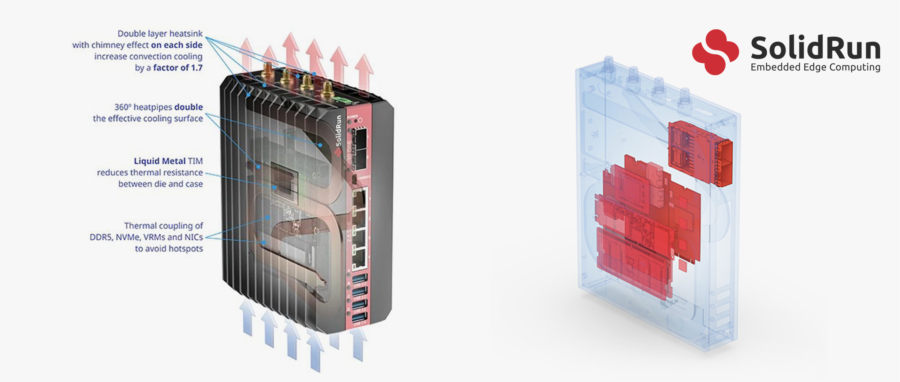
Cooling Secondary Heat Sources
Cooling the secondary heat sources is a key requirement for reliable 24/7 operation under extreme storage or networking utilisation profiles. All power dissipating devices inside SolidRun’s Bedrock V3000 Basic are thermally coupled to the chassis, including the 3 NVMe, both SODIMMs, power FETs, NICs, SFP+ cages, WiFi adapter and 5G modem.
Rock Solid Reliability
Bedrock is designed with reliability in mind based on decades of experience in development of IPCs and embedded systems. DC power is through a terminal block with screw locking and has a wide voltage range of 12V – 60V with two stages of regulation. RAM supports ECC. NVMe with power-loss-protection (PLP) can be ordered. Bedrock has redundant SPI Flash to prevent bricking by BIOS corruption as well as WDT and TPM. The enclosure is extremely ruggedized – all-aluminium, fanless and ventless dust-resistant IP40.
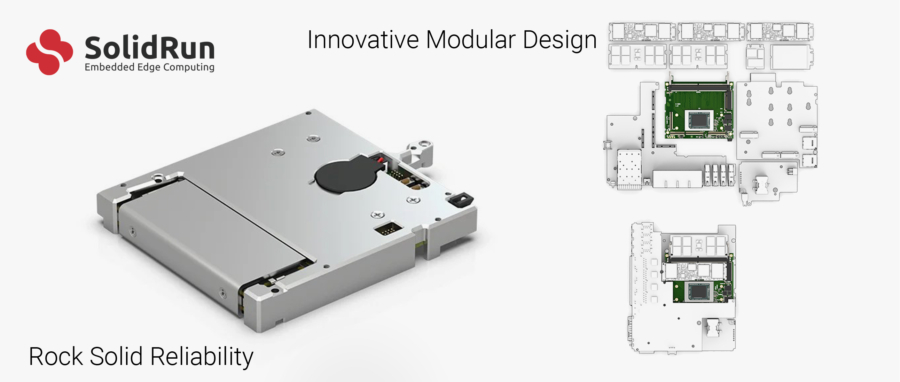
Innovative Modular Design
Bedrock is designed to address the diversity of requirements in the IoT space. This is achieved by partitioning the hardware into the following boards:
- SoM with the CPU, DDR5 and NVMe slots and all native interfaces on 380 pins of high density connectors.
- Networking and I/O board (NIO) with NICs and ports.
- Storage and Extension Cards board (SX) with slots for WiFi, 5G modem and extra NVMe devices.
- Power Module (PM) with DC to DC converter and DC input connector.
This modular design enables agile customization of Bedrock for addressing specific requirements. SolidRun is developing multiple NIO, SX and PM boards that can be mixed and matched as an off-the-shelf solution and also offers development of custom boards as an ODM service. Customers and 3rd parties that are interested in developing custom NIO, SX or PM boards are welcome to contact SolidRun for support.
Bedrock enclosure is designed with customization in mind. Modification of I/O, power input, antenna openings etc. can be performed cost-effectively even in small volume.
Painless Integration
The compact footprint of Bedrock, robust structure, effective fanless cooling and DC input tolerance simplify Bedrock integration. All Bedrock I/O is brought to the front panel, with DC input and antennas in the top panel. The bottom and rear panel are both reserved for mounting, allowing full usability while Bedrock is mounted to a wall or to a desk.
SolidRun offers multiple types of mounting brackets, including lever-based DIN-Rail bracket with locking, wall mount, small stand and ruggedised stand.
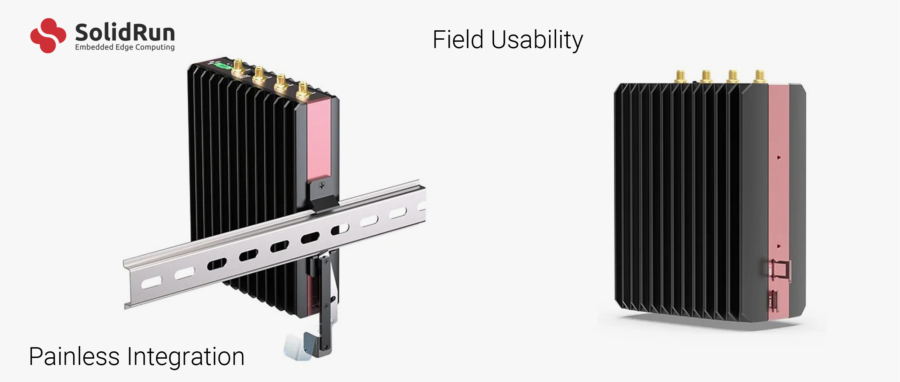
Field usability
As a fanless, ventless IPC Bedrock requires no maintenance. Bedrock is designed to avoid the need to open it in the field. SIM cards are accessible from the panel using pin-hole trays. Remote power button connector is conveniently located on the top panel. All brackets and mounting fixtures are assembled from the outside. Should the need arise to open Bedrock (e.g. to install a storage device or replace the RTC battery) Bedrock opens by unscrewing a single screw.
The 0.6 Litre Bedrock Tile
When integrating an Industrial Computer in tight space convection cooling becomes ineffective and is better replaced with conduction cooling. It is also desirable to make the system as compact and thin as possible.
Bedrock Tile is designed for these use cases. The ribbed chassis walls are replaced with flat walls with blind threadings for fastening Bedrock Tile to a cold plate. A key feature of Bedrock Tile is that it preserves the 360º internal heat distribution so it can be cooled from either side. With thickness of just 29mm and volume of 0.6 litre, Bedrock Tile is easy to integrate in tight spaces. Having all connectors on one side further simplifies the integration.
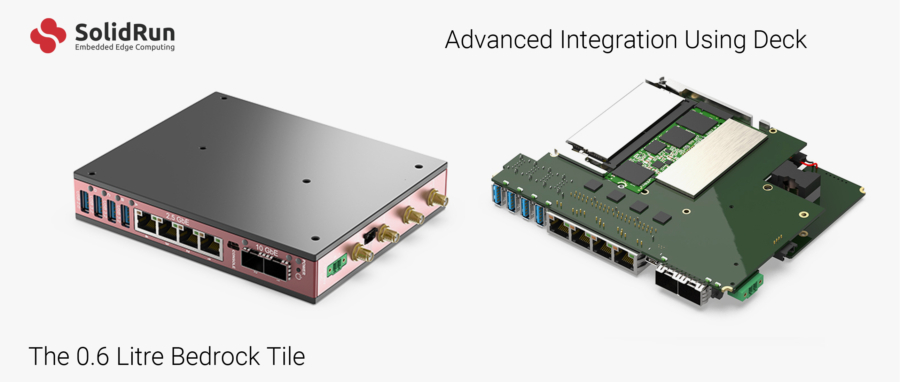
Advanced Integration Using Deck
Some integration scenarios call for custom enclosures (e.g. when additional devices must be installed with the computer in the same housing). To support these use cases Bedrock introduces the Deck concept (deck-of-cards). The SoM, NIO, SX and PM are rigidly held together with fasteners independently of the Bedrock enclosure. The Deck provides first stage cooling for most devices, in particular it includes a copper heat-plate on the CPU. The Deck is fastened to the custom chassis with only 3 screws. Fastening provides thermal coupling to the CPU, RAM, NVMe and FETs. The DC input connector is on wires and can be relocated in the chassis.

Designing with Bedrock SoM
Bedrock SoM makes a convenient and flexible building block for board designers. For many developers, using Bedrock R7000 SoM would be the best way to develop a custom appliance based on the popular AMD RyzenTM 7040 series. Bedrock SoM makes an attractive platform for that purpose for several reasons.
The SoM is far more self-contained than traditional SoMs. It has not only the essential CPU and RAM, but also NVMe, direct DC input with 12V – 19V tolerance and RTC battery. The SoM is provided in a ruggedised metal skirt that protects the SoM, provides mounting fixture for extension cards and serves as a heat-spreader for secondary heat sources. Copper heat-plate is pre-assembled on the CPU.
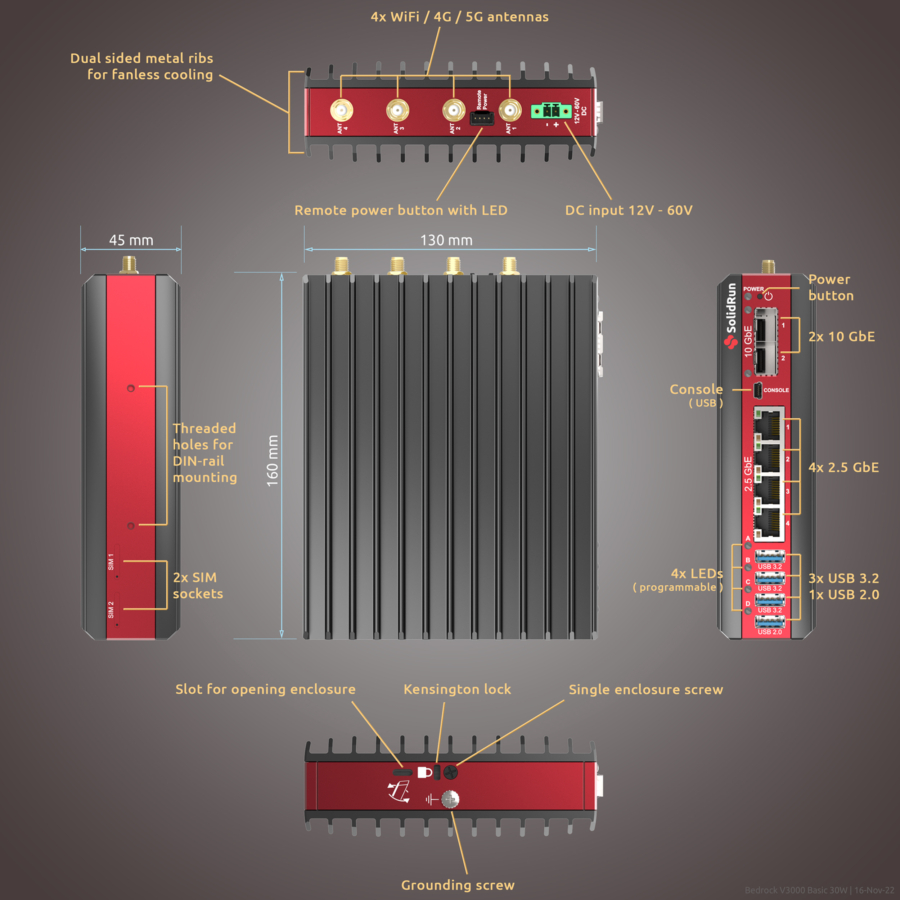
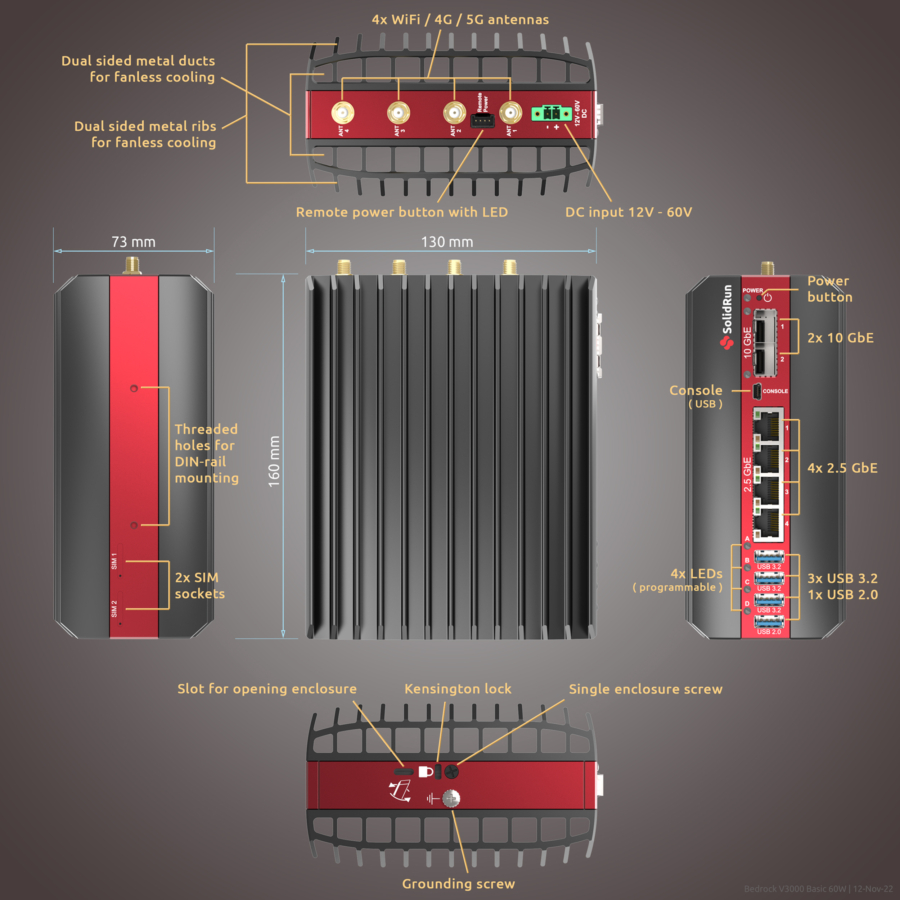
Bedrock R7000 Basic
Bedrock R7000 Basic is a high-performance fanless industrial computer, based on AMD Ryzen™ 7840HS Zen4 “Phoenix” for demanding applications in harsh environments.
Unmatched Fanless Performance
- 1st fanless industrial PC with AMD Ryzen 7840HS Zen4 “Phoenix”
- High performance Radeon 780M RDNA3 GPU with four displays
- State of the art thermal design for operation in -40ºC to 85ºC
- Easy-to-integrate compact design with DIN-Rail mounting, 12V-60V DC input
Power & Efficiency in Perfect Balance
SolidRun Bedrock R7000 Basic is powered by AMD RyzenTM 7 7840HS / 7840U processor with 8 Zen 4 cores and 16 threads running at up to 5.1 GHz. The APU has an integrated AMD RadeonTM 780M GPU with 12 CUs running at 2700 MHz.
The chip is fabricated using TSMC state-of-the-art 4nm FinFET process, and is the most power efficient high-performance x86 CPU on the market for compute and graphics workloads.

Packed Solid with Features
The I/O, storage and networking devices found in SolidRun’s Bedrock R7000 Basic stand out in both performance and capacity. 4 display outputs HDMI 2.1 / DP 2.1 each 8K capable or 4x4K are driven by the powerful Radeon 780M GPU. 64 GB DDR5 with ECC, 3x NVME Gen4 2280, 2x 2.5 GbE ports, WiFi 6E, 5G modem with dual SIM and 4 USB ports. All these features are tightly packed in a fanless enclosure of under 1 litre.
Remarkable Fanless Cooling
Hot chips require innovative cooling. Bedrock was designed from the ground up for effective fanless cooling. The CPU is thermally coupled to the chassis using liquid metal TIM to reduce thermal resistance. Stacked heat pipes distribute the heat evenly 360º around the all-aluminium chassis. To optimise convective heat transfer, each chassis wall has two heat exchange layers – aluminium air-ducts that stimulate airflow by chimney effect, and another layer of conventional cooling ribs. As a result, Bedrock can dissipate over 3 times the power of fanless computers of similar size.
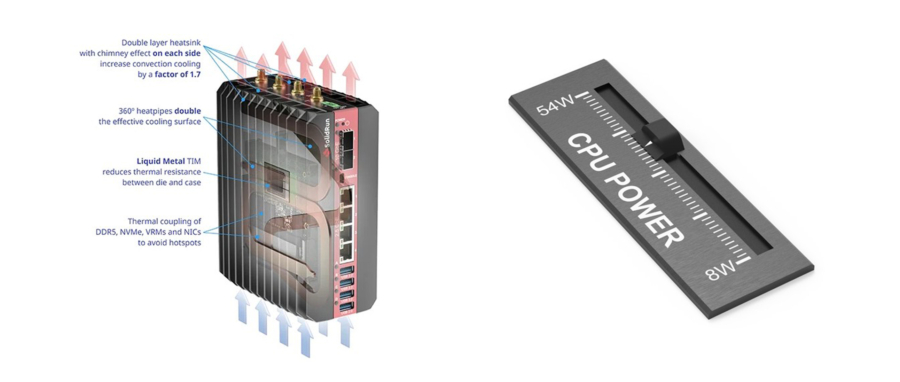
Full Control of CPU Power
With Bedrock R7000 you don’t have to guess how much power the system draws. Instead you can precisely set CPU power limit across an exceptionally broad power range of 8W to 54W. This is particularly useful in scenarios where limited power has to be shared between the industrial computer and additional devices, and when integration constraints prevent ideal heat dissipation.
Rock Solid Reliability
Bedrock is designed with reliability in mind based on decades of experience in development of industrial computers and embedded systems. DC power is through a terminal block with screw locking and has a wide voltage range of 12V – 60V with two stages of regulation. RAM supports ECC. NVMe with power-loss-protection (PLP) can be ordered. Bedrock has redundant SPI Flash to prevent bricking by BIOS corruption as well as WDT and TPM. The enclosure is extremely ruggedized – all-aluminium, fanless and ventless dust-resistant IP40.
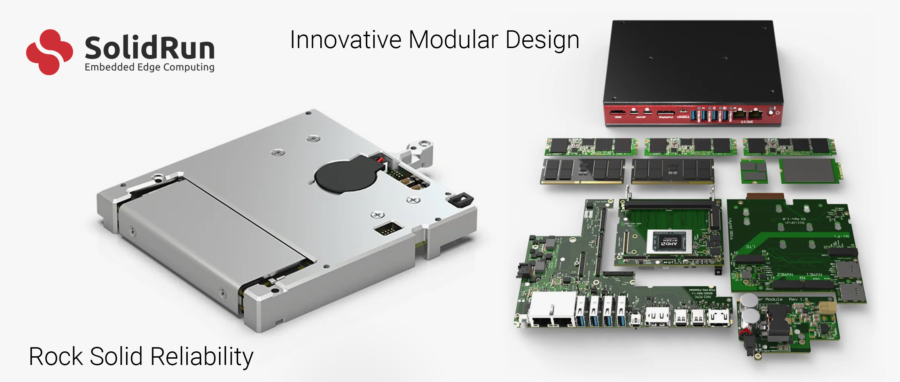
Innovative Modular Design
Bedrock is designed to address the diversity of requirements in the IoT space. This is achieved by partitioning the hardware into the following boards:
- SoM with the CPU, DDR5 and NVMe slots and all native interfaces on 380 pins of high density connectors.
- Networking and I/O board (NIO) with NICs and ports.
- Storage and Extension Cards board (SX) with slots for WiFi, 5G modem and extra NVMe devices.
- Power Module (PM) with DC to DC converter and DC input connector.
This modular design enables agile customization of Bedrock for addressing specific requirements. SolidRun is developing multiple NIO, SX and PM boards that can be mixed and matched as an off-the-shelf solution and also offers development of custom boards as an ODM service. Customers and 3rd parties that are interested in developing custom NIO, SX or PM boards are welcome to contact SolidRun for support.
Bedrock enclosure is designed with customization in mind. Modification of I/O, power input, antenna openings etc. can be performed cost effectively even in small volume.
Painless Integration
The compact footprint of Bedrock, robust structure, effective fanless cooling and DC input tolerance simplify Bedrock integration. All Bedrock I/O is brought to the front panel, with DC input and antennas in the top panel. The bottom and rear panel are both reserved for mounting, allowing full usability while Bedrock is mounted to a wall or to a desk.
SolidRun offers multiple types of mounting brackets, including lever-based DIN-Rail bracket with locking, wall mount, small stand and ruggedized stand.
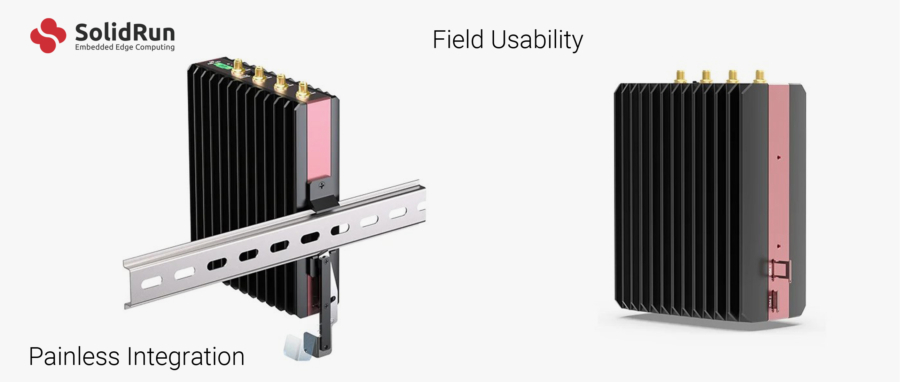
Field Usability
As a fanless, ventless IPC Bedrock requires no maintenance. Bedrock is designed to avoid the need to open it in the field. SIM cards are accessible from the panel using pin-hole trays. Remote power button connector is conveniently located on the top panel. All brackets and mounting fixtures are assembled from the outside. Should the need arise to open Bedrock (e.g. to install a storage device or replace the RTC battery) Bedrock opens by unscrewing a single screw.
The 0.6 litre Bedrock Tile
When integrating an Industrial Computer in tight space convection cooling becomes ineffective and is better replaced with conduction cooling. It is also desirable to make the system as compact and thin as possible.
Bedrock Tile is designed for these use cases. The ribbed chassis walls are replaced with flat walls with blind threadings for fastening Bedrock Tile to a cold plate. A key feature of Bedrock Tile is that it preserves the 360º internal heat distribution so it can be cooled from either side. With thickness of just 29mm and volume of 0.6 litre, Bedrock Tile is easy to integrate in tight spaces. Having all connectors on one side further simplifies the integration.
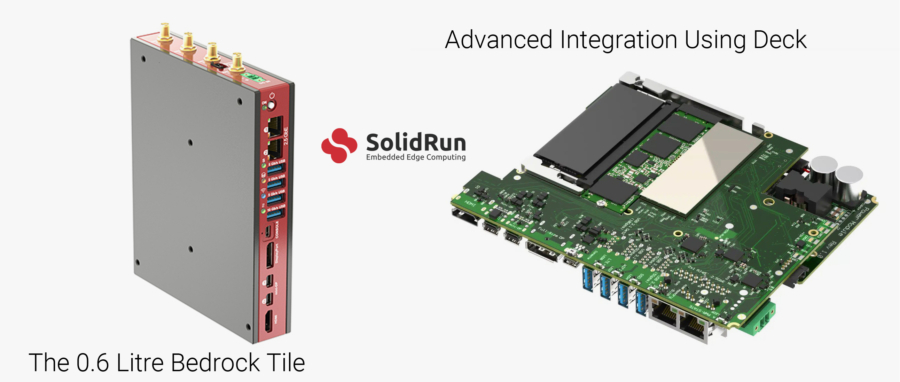
Advanced Integration Using Deck
Some integration scenarios call for custom enclosures (e.g. when additional devices must be installed with the computer in the same housing). To support these use cases Bedrock introduces the Deck concept (deck-of-cards). The SoM, NIO, SX and PM are rigidly held together with fasteners independently of the Bedrock enclosure.
The Deck provides first stage cooling for most devices, in particular it includes a copper heat-plate on the CPU. The Deck is fastened to the custom chassis with only 3 screws. Fastening provides thermal coupling to the CPU, RAM, NVMe and FETs. The DC input connector is on wires and can be relocated in the chassis.
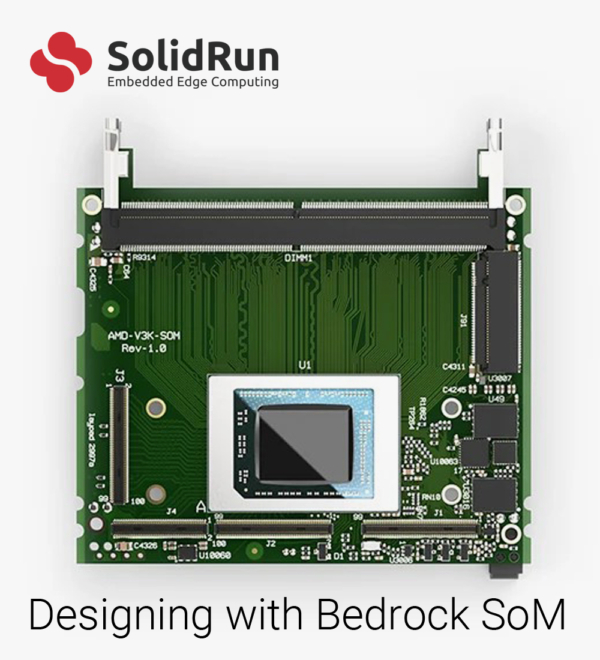
Designing with Bedrock SoM
Bedrock SoM makes a convenient and flexible building block for board designers. For many developers, using Bedrock R7000 SoM would be the best way to develop a custom appliance based on the popular AMD RyzenTM 7040 series. Bedrock SoM makes an attractive platform for that purpose for several reasons.
The SoM is far more self-contained than traditional SoMs. It has not only the essential CPU and RAM, but also NVMe, direct DC input with 12V – 19V tolerance and RTC battery. The SoM is provided in a ruggedized metal skirt that protects the SoM, provides mounting fixture for extension cards and serves as a heat-spreader for secondary heat sources. Copper heat-plate is pre-assembled on the CPU.
The R7000 Basic is available in three models; Tile, 30W and 60W.
